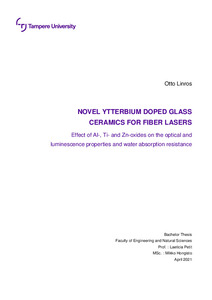Novel ytterbium doped glass ceramics for fiber lasers: Effect of Al-, Ti- and Zn-oxides on the optical and luminescence properties and water absorption resistance
Linros, Otto (2021)
Linros, Otto
2021
Tekniikan ja luonnontieteiden kandidaattiohjelma - Bachelor's Programme in Engineering and Natural Sciences
Tekniikan ja luonnontieteiden tiedekunta - Faculty of Engineering and Natural Sciences
This publication is copyrighted. You may download, display and print it for Your own personal use. Commercial use is prohibited.
Hyväksymispäivämäärä
2021-04-19
Julkaisun pysyvä osoite on
https://urn.fi/URN:NBN:fi:tuni-202104193092
https://urn.fi/URN:NBN:fi:tuni-202104193092
Tiivistelmä
Phosphate laser glasses and glass ceramics are versatile materials, whose potential as a fiber laser core material has been studied. Often the lasing properties of a phosphate glass ceramic is not sufficient for laser applications, partly because the high water concentrations of phosphate glasses and glass ceramics lower the optical and luminescence powers of the material. Therefore, the goal of this study was to develop a new ytterbium doped oxyphosphate glass system with enhanced water resistance and lasing properties, and to study its compatibility to prepare a glass-ceramic, ultimately to be used in fiber laser glass cores.
An existing glass composition of (98.75) [(90)NaPO3 – (10)Na2O] – (1.25)Yb2O3 was modified by adding metal oxides into it, with the aim to enhance its water resistance and lasing properties. The added metal oxides were chosen to be Al2O3, TiO2 and ZnO. The prepared glasses were also heat-treated into glass ceramics. The absorption coefficients and absorption cross-sections at approximately 975 nm were measured to evaluate the optical properties, and emission intensities and emission cross-sections were measured to evaluate the luminescence properties. The IR-spectra of the glasses were measured to check the presence of water in the glasses. Thermal analysis (DSC) and density measurements were conducted to evaluate the thermal and physical properties of the glasses. Also, the heat-treated glasses were studied with an XRD, to analyze their crystalline structure and composition.
The addition of Al2O3 and TiO2 leads to an increase in the measured thermal properties, while the addition of ZnO showed no impact on the thermal properties. Addition of all the oxides showed an increase on the optical and luminescence properties, and a clear decrease on the water content of the glasses. Heat-treatment leads to the growth of a crystalline phase of NaYb(P2O7) in all the glasses. Overall, the new glass compositions appear to be more water resistant than the base glass. The new glasses have increased optical and luminescence properties, and show a promise to be turned into optically active glass ceramics, possibly to be further used in fiber lasers.
Further research should be done on the long-term water absorption of these and similar glasses. The heat-treatment of the glasses should also be further optimized to achieve transparent glass ceramic, rich with Yb3+ containing crystalline phases in the bulk. Additionally, similar research needs to be done with different metal oxides, for example MgO and Li2O which have been shown to be promising in other studies, to determine the best candidate for fiber laser applications.
An existing glass composition of (98.75) [(90)NaPO3 – (10)Na2O] – (1.25)Yb2O3 was modified by adding metal oxides into it, with the aim to enhance its water resistance and lasing properties. The added metal oxides were chosen to be Al2O3, TiO2 and ZnO. The prepared glasses were also heat-treated into glass ceramics. The absorption coefficients and absorption cross-sections at approximately 975 nm were measured to evaluate the optical properties, and emission intensities and emission cross-sections were measured to evaluate the luminescence properties. The IR-spectra of the glasses were measured to check the presence of water in the glasses. Thermal analysis (DSC) and density measurements were conducted to evaluate the thermal and physical properties of the glasses. Also, the heat-treated glasses were studied with an XRD, to analyze their crystalline structure and composition.
The addition of Al2O3 and TiO2 leads to an increase in the measured thermal properties, while the addition of ZnO showed no impact on the thermal properties. Addition of all the oxides showed an increase on the optical and luminescence properties, and a clear decrease on the water content of the glasses. Heat-treatment leads to the growth of a crystalline phase of NaYb(P2O7) in all the glasses. Overall, the new glass compositions appear to be more water resistant than the base glass. The new glasses have increased optical and luminescence properties, and show a promise to be turned into optically active glass ceramics, possibly to be further used in fiber lasers.
Further research should be done on the long-term water absorption of these and similar glasses. The heat-treatment of the glasses should also be further optimized to achieve transparent glass ceramic, rich with Yb3+ containing crystalline phases in the bulk. Additionally, similar research needs to be done with different metal oxides, for example MgO and Li2O which have been shown to be promising in other studies, to determine the best candidate for fiber laser applications.
Kokoelmat
- Kandidaatintutkielmat [7047]
